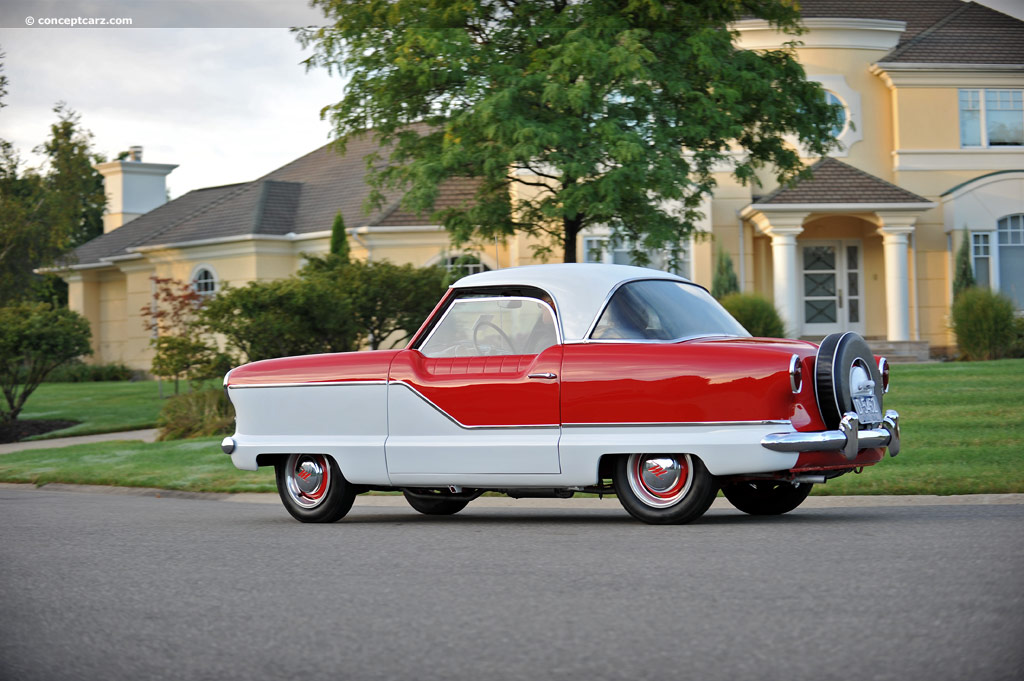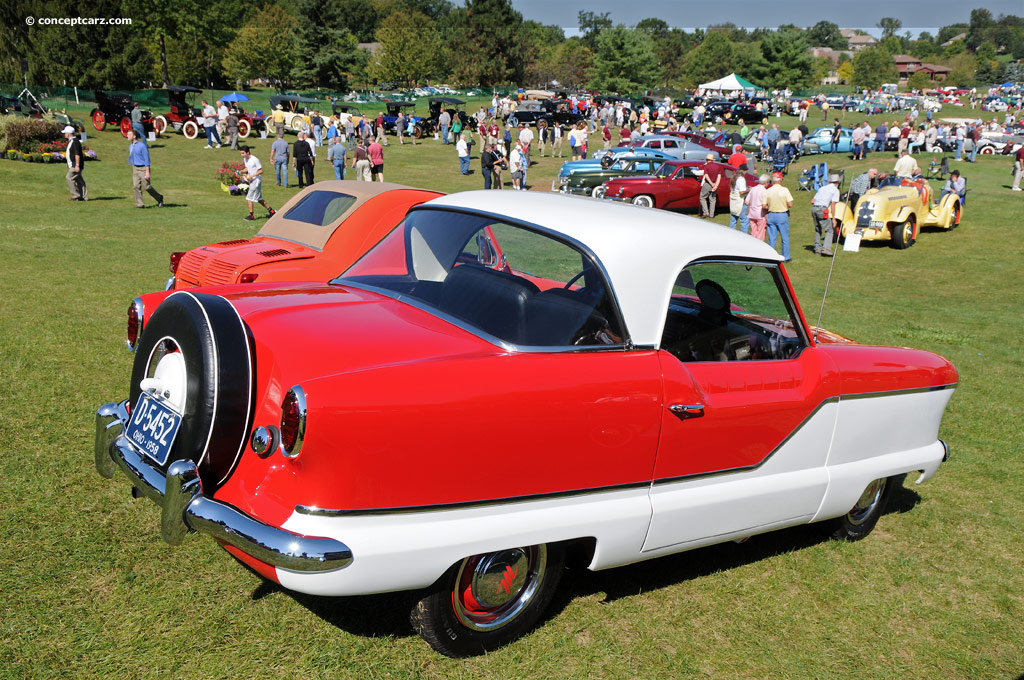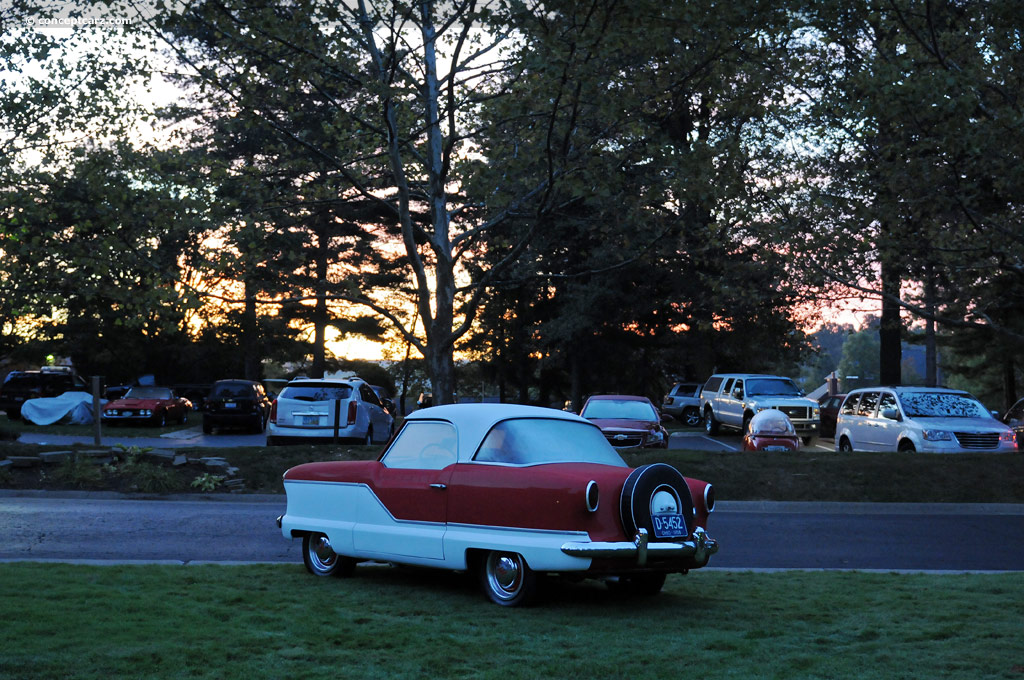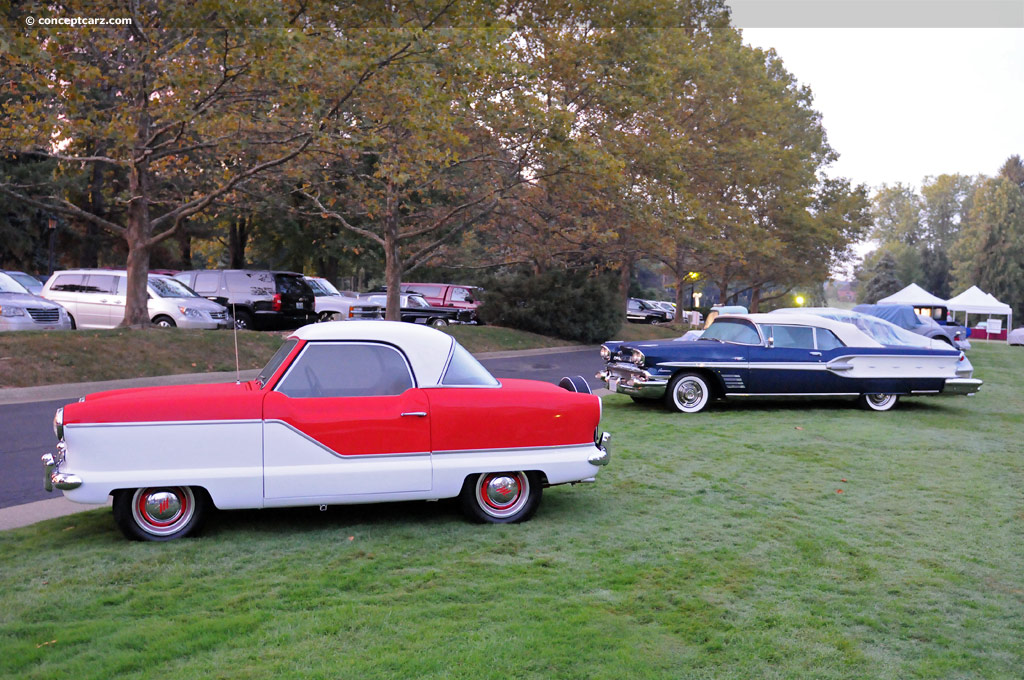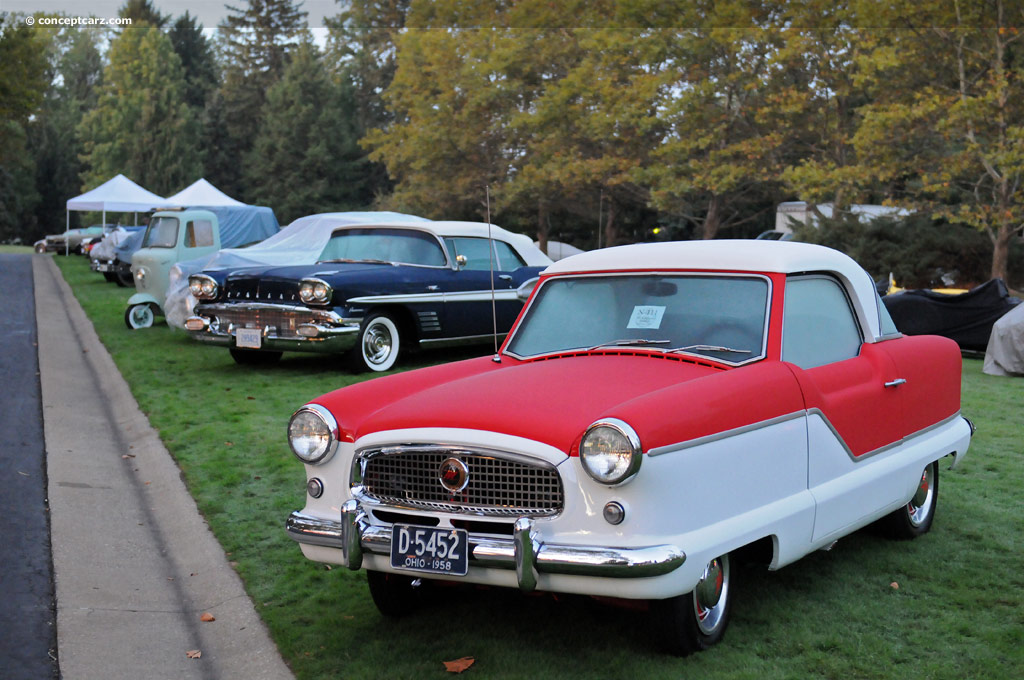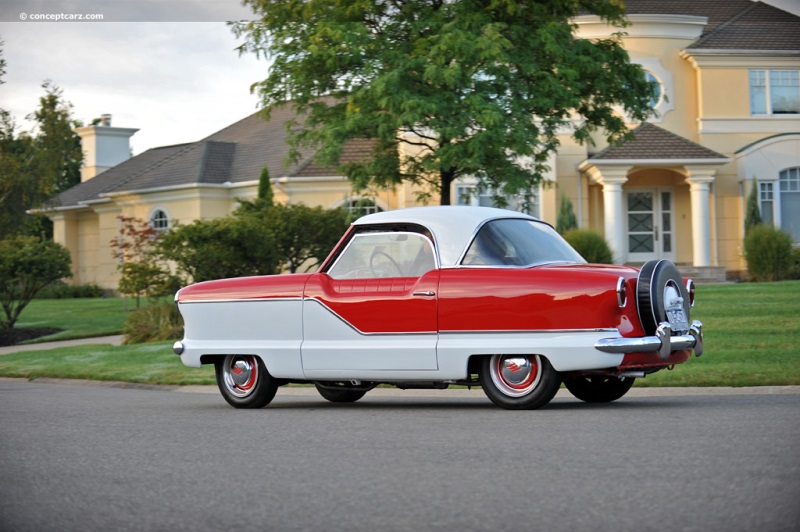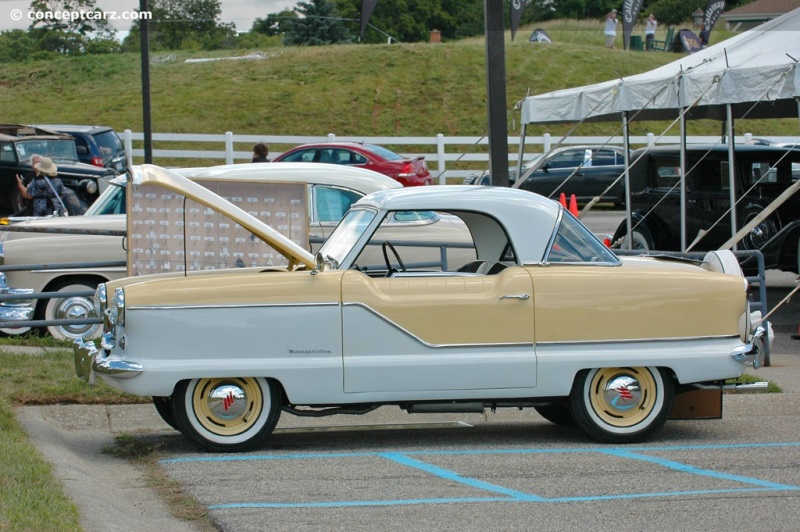1958 Nash Metropolitan Navigation
On May 1st of 1954, Hudson Motor Car Company and Nash-Kelvinator combined to form American Motors. This merger was necessary and done for survival, not only for Hudson but for Nash as well. This was not Nash's first merger as it had joined forces in 1937 with the Kelvinator Corporation, a well-known maker of refrigerators. This union was the result of company founder Charles Nash wanting George Mason as his executive vice president. To get Mason, Nash had to acquire Kelvinator. With Mason at the helm, the company broke new ground in several areas, such as the importation of cars built jointly by Nash, British automaker Donald Healey, and Italian coachbuilder Pinin Farina. At the time, most of the market was offering large cars which grew larger year-over-year, highlighted with chrome trim and space-age design cues such as towering tailfins. Mason's philosophy was to go in the opposite direction and offer buyers something the Big-Three did not - a small vehicle with elegant, non-flamboyant styling. In 1950, the compact Rambler began rolling out of the company's factories.
Coupe
Chassis #: E43757
View info and history
Auction entries : 1The company went a step further in 1954 with the introduction of a new model called the Metropolitan. The bodies were built in England by Fisher and Ludlow, and the four-cylinder engine was by Austin, which did the final assembly. Both Hudson and Nash dealers offered the car with claims of up to 40 mpg. Body styles included a hardtop and convertible at a cost of $1,445 for the closed body style and $1,495 for the convertible. Upscale features were standard which helped segregate it from vehicles with similar price points. The styling, based on the NX1 show car, appeared not unlike a three-quarter version of the big Nash. It had enclosed front wheels and a continental spare tire out back. In total, five pre-production prototypes were built by Austin Motors prior to the start of production. The first pre-production prototype was completed by Austin on December 2nd of 1952. The Metropolitan was designed in America, marketed exclusively to North America, and built entirely in Europe. Thus, it was a foreign-built vehicle sold and serviced by Nash (later American Motors) through its dealer distribution system. The Metropolitan was an economical and dependable form of transportation and even its name gave it an allure of sophistication. Its advertising was aimed squarely at women as its tiny size made it an easy car to drive and park. Beginning with the 1956 model year, Metropolitans were equipped with a new, larger engine. Called the A-50, the 1,500 cc cast-iron four-cylinder featured overhead valves and offered 52 horsepower (a 10-horsepower improvement). The year 1959 marked the addition of several improvements to the model, including an outside trunk lid that greatly improved access to the rear storage area. Front vent windows were added to improve ventilation, and larger tires, 5.60x13s, were fitted, along with two inches more seat travel and redesigned seats.Specifications
The 'baby nash,' as it was nicknamed, had an 85-inch wheelbase, an overall length of 149.5 inches, and a gross weight of 1,785 lbs for the Convertible and 1,825 for the hardtop. These dimensions made the Metropolitan smaller than the Volkswagen Beetle. In the front was an independent coil-spring suspension with wishbones while the rear used a live axle with semi-elliptical leaf springs. Four-wheel Girling hydraulic drum brakes provided the stopping power. Power was from an overhead valve 1,200cc (73 cubic-inch) straight-4 cylinder Austin 'A40' series engine which also powered the Austin A40 Devon and Dorset. A three-speed manual transmission sent the power to the rear wheels.
Coupe
Chassis #: E43195
View info and history
Auction entries : 1Zero-to-sixty mph was accomplished in just over 20 seconds and was capable of nearly 40 mpg. Although not quick, it was faster than the Volkswagen Beetle's zero-to-sixty mph time of circa-40 seconds. The top speed was in the neighborhood of 70 mph.Design
The Metropolitan was designed in Kenosha, Wisconsin, and patterned after the NXI (Nash Experimental International) that had been created by Detroit-based independent designer William J. Flajole for Nash-Kelvinator. Its design resembled the larger Nash models and its purpose was as a second car to run errands and take the kids to school. Unique features of the NXI design study included interchangeable front and rear components and Nash's advanced single-unit (unit body) construction. The only interchangeable items from the NXI's incorporated into the production model were the symmetrical door skins. It had a floor shift transmission, bucket-type seats, and was devoid of roll-up glass side windows.The NXI Design Study was shown to the American motoring public at various venues beginning on January 4th of 1950 at the Waldorf-Astoria Hotel in New York. The public reaction was positive and further encouraged Nash to put it into production. Another prototype was built, known as the NKI (for Nash-Kelvinator International), with a more potent engine, a column-mounted transmission, a bench seat, and roll-up glass side windows. At the time, the styling for Nash vehicles had been performed both in-house and by Pinin Farina, and since the Metropolitan took several design elements from its larger sibling, the Metropolitan was an amalgam of these designs. 'Family' design features included the notched 'pillow' style door pressing, bar-style grille, and fully enclosed front wheels.Following the Nash-Kelvinator Corporation's merger with the Hudson Motor Company, forming American Motors Corporation (AMC), the Metropolitans available through the Hudson dealers carried a Hudson grille badge, a plain spare wheel cover, hubcaps with an 'M' logo, and a 'bulls-eye' horn button design. Access to the truck was via the rear seatback, but this eventually changed in 1959 (with the Series IV) when an external decklid was adopted which added vent windows and an open-piece rear window. Production
It was believed that having the Metropolitan built overseas would be the most cost-effective option, as that is where the mechanical components existed, including the brakes, suspension, rear end, engine, transmission, and electrical system. After exploring options with several European companies, the Austin Motor Company was selected in early October of 1952. At the time, Austin Motor was part of BMC and based in Birmingham, England, in close proximity to Fisher & Ludlow which later became part of BMC in September of 1953. It later operated under the name Pressed Steel Fisher. The mechanical production and final assembly were performed by the Austin Motor Company while Fisher & Ludlow was responsible for the bodywork. Standard and Optional Features
Among the list of standard features bestowed upon the Metropolitan were electric windshield wipers, a cigar lighter, a map light, and a 'continental-type' rear-mounted spare tire with cover. The interior was finished in 'Bedford cord' upholstery trimmed with leather. Items on the options list included a 'Weather Eye' heater, whitewall tires, and an AM radio. The Nash/Hudson Metropolitan
The Metropolitan was marketed by Nash and Hudson between 1954 and 1957, and then by American Motors from 1958 through 1962. Production lasted from October of 1953 through April of 1961 with a total of 94,986 units built. Of those, 83,442 went to the United States and 11,544 to Canada. Although Nash had done its 'due diligence' with gauging the American public for economy cars with its pre-production prototypes, the early hype did not translate into strong sales. The highest production year was in 1959 with 22,209 units sold. 420 were sold in 1962, 969 in 1961, and 743 in its inaugural year of 1953.At the end of 1956, the Austin Motor Company began producing the Metropolitan for sale in Europe (with permission from American Motors). Sales begin on April 2nd of 1957 and approximately 9,400 units were sold in overseas markets that included the United Kingdom and New Zealand. Of those, as few as 1,200 and as many as 5,000 were sold to the UK market over a period of four years. Production of the Austin Metropolitan ended in February 1961. The Metropolitan was built through four distinct series, beginning with the Series I and continuing through the Series IV. Among the updates made through these 'series' included upgrades to the engine and gearbox, new exterior colors, new upholstery, changes to the dashboard, and styling modifications.The Metropolitan Series I
Austin's Longbridge factory began production in October of 1953, beginning in VIN number 1001, after receiving an initial order for 10,000 units. The first examples were badged as Nash and went on sale on March 19th of 1954. They were going to be called the 'NKI Custom,' but two months prior to its public release, the name was changed to 'Metropolitan.' Some early factory manuals had already been printed and distributed to service departments with the NKI name, and new chrome nameplates with the name 'Metropolitan' had to be created to fit into the holes designed for the 'NKI Custom' script on the passenger side front fender.The Series I Metropolitan was powered by a 1,200cc straight-4 OHV Austin 'A40' series engine backed by a three-speed manual transmission with a mechanical clutch linkage). A total of 10,000 examples were built (the initial order).The Metropolitan Series II
Production of the Series II, also known as the NK2, began with VIN E11001 on August 19th of 1954 and would continue through late 1955. Changes were minimal with the most substantial being the replacement of the Austin 'A40' series engine with a B-Series unit, albeit the displacement size remained the same, but it did add an additional 50 pounds. The engine was paired with a new gearbox and hydraulic actuation for the clutch.The Metropolitan Series III
Production of the Series III (NK3) began in November of 1955 beginning with VIN E21008 and among the changes was a displacement increase of the B-Series engine to 1,498cc (91.4 cubic inches). With this change, American Motors re-designated the Metropolitan to the 'Metropolitan 1500' to further distinguish it from the earlier '1200cc' models. On October 15th of 1957, beginning with VIN E43116, the compression ratio was raised from 7.2:1 to 8.3:1, bringing output to 55 bhp.In September 1957, AMC announced that it was dropping the Nash and Hudson brand names. The Metropolitan was subsequently marketed under the 'Metropolitan' name only and sold through Rambler dealers.The Series III hardtop had an MSRP of $1,527 and the convertible at $1,551.The most visual change introduced by the Series III was the two-tone paint scheme, separated by polished stainless steel sweep-spears. The front grille was redesigned with the previous single bar with a round-centered logo replaced with mesh styling (the round-centered logo remained). The non-function hood scoop was removed.New Exterior Colors
The list of new two-tone exterior colors included P911 'Coral Red', P905 'Caribbean Green' and P910 'Sunburst Yellow' with P909 'Snowberry White' as a contrast. After VIN E35133, which was produced on April 16th of 1957, the color list changed to P912 'Berkshire Green', and P913 'Mardi-Gras Red', P910 'Sunburst Yellow' with P914 'Frost White' as a contrast. The color list changed once again, following VIN E45912 built on January 9th of 1958, with the P910 'Sunburst Yellow' being replaced by P915 'Autumn Yellow' and P908 'Classic Black' was added to the available exterior colors.New Interior Changes
The dashboard color of the Series I and II Metropolitans was the same as the exterior body color. For all Series III Metropolitans, the dashboard was now painted black. The Metropolitan Series IV
The Series IV was the final iteration of the Metropolitan, with production commencing in January of 1959 beginning with VIN E59048 and continuing through April of 1961, ending with VIN E95981. The engine's compression continued to be 8.3:1 and the exterior color options remained the same as the Series III. The interior upholstery was changed to a diamond pattern for the seats, with white vinyl trim. The major design change for the Seris IV was the aforementioned external decklid, vent windows, and one-piece rear window. Closing Thoughts
When viewing the Metropolitan as it was intended - to be a second car for running errands - the Metropolitan seems practical. In nearly every scenario, except as a city car, its small stature, limited storage accommodations, and underwhelming performance for the vast American roadway is less appealing. Its whimsical design was trendy, unique, and attractive but when sold in countries where microcars thrived, the design proved to be its Achilles heel and was considered too outlandish against the backdrop of the more sober-styled vehicles on the road. Sales in the United States increased closer to the end of its lifespan, perhaps due to the public's growing willingness to embrace smaller and more economical vehicles, as evidenced by the new line of compact cars emerging from the Big Three. Perhaps it was in response to the economic downturn of 1958 (the Eisenhower Recession), the most significant recession during the post-World War II boom (1945 and 1970), sending buyers to seek more frugal means of transportation. By the time production of the Nash/Hudson/AMC/Austin Metropolitan had come to a close, it had certainly captured the hearts and admiration of automotive enthusiasts around the globe. Perhaps the best way to describe the Metropolitan is cute and cuddly.
by Daniel Vaughan | Jan 2022
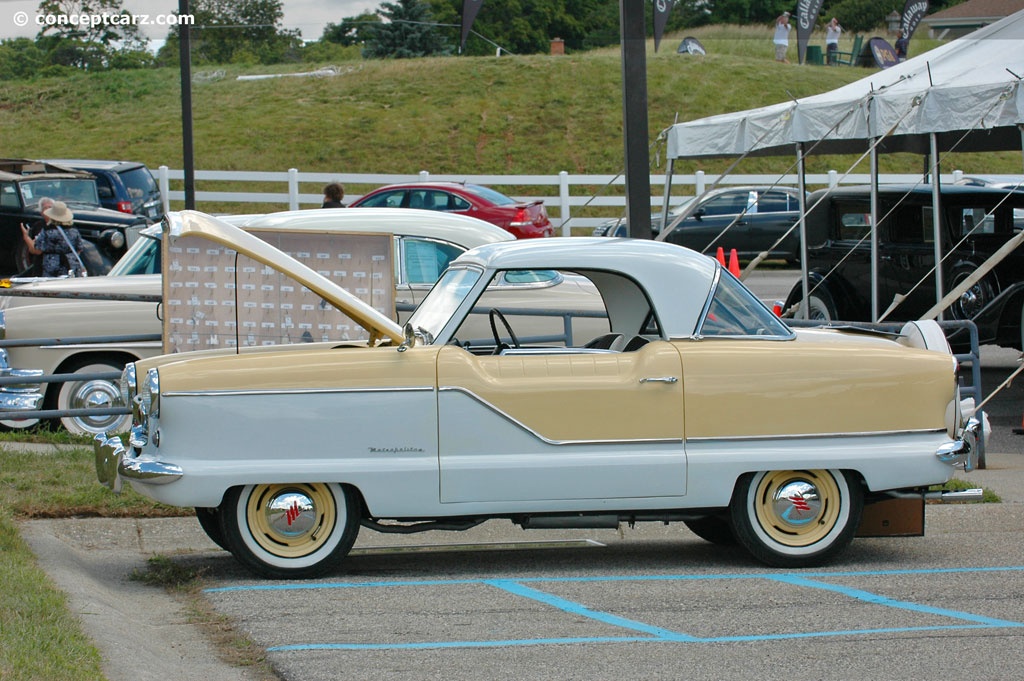
Coupe
Chassis #: E43757
View info and history
Auction entries : 1
The 'baby nash,' as it was nicknamed, had an 85-inch wheelbase, an overall length of 149.5 inches, and a gross weight of 1,785 lbs for the Convertible and 1,825 for the hardtop. These dimensions made the Metropolitan smaller than the Volkswagen Beetle. In the front was an independent coil-spring suspension with wishbones while the rear used a live axle with semi-elliptical leaf springs. Four-wheel Girling hydraulic drum brakes provided the stopping power. Power was from an overhead valve 1,200cc (73 cubic-inch) straight-4 cylinder Austin 'A40' series engine which also powered the Austin A40 Devon and Dorset. A three-speed manual transmission sent the power to the rear wheels.
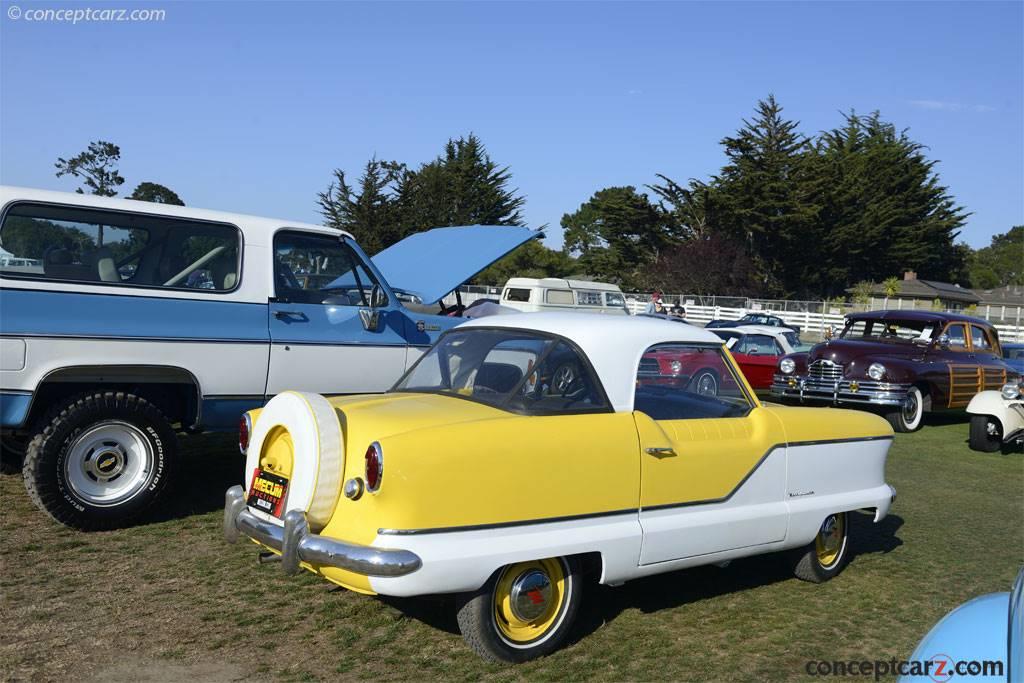
Coupe
Chassis #: E43195
View info and history
Auction entries : 1
The Metropolitan was designed in Kenosha, Wisconsin, and patterned after the NXI (Nash Experimental International) that had been created by Detroit-based independent designer William J. Flajole for Nash-Kelvinator. Its design resembled the larger Nash models and its purpose was as a second car to run errands and take the kids to school. Unique features of the NXI design study included interchangeable front and rear components and Nash's advanced single-unit (unit body) construction. The only interchangeable items from the NXI's incorporated into the production model were the symmetrical door skins. It had a floor shift transmission, bucket-type seats, and was devoid of roll-up glass side windows.The NXI Design Study was shown to the American motoring public at various venues beginning on January 4th of 1950 at the Waldorf-Astoria Hotel in New York. The public reaction was positive and further encouraged Nash to put it into production. Another prototype was built, known as the NKI (for Nash-Kelvinator International), with a more potent engine, a column-mounted transmission, a bench seat, and roll-up glass side windows. At the time, the styling for Nash vehicles had been performed both in-house and by Pinin Farina, and since the Metropolitan took several design elements from its larger sibling, the Metropolitan was an amalgam of these designs. 'Family' design features included the notched 'pillow' style door pressing, bar-style grille, and fully enclosed front wheels.Following the Nash-Kelvinator Corporation's merger with the Hudson Motor Company, forming American Motors Corporation (AMC), the Metropolitans available through the Hudson dealers carried a Hudson grille badge, a plain spare wheel cover, hubcaps with an 'M' logo, and a 'bulls-eye' horn button design. Access to the truck was via the rear seatback, but this eventually changed in 1959 (with the Series IV) when an external decklid was adopted which added vent windows and an open-piece rear window. Production
It was believed that having the Metropolitan built overseas would be the most cost-effective option, as that is where the mechanical components existed, including the brakes, suspension, rear end, engine, transmission, and electrical system. After exploring options with several European companies, the Austin Motor Company was selected in early October of 1952. At the time, Austin Motor was part of BMC and based in Birmingham, England, in close proximity to Fisher & Ludlow which later became part of BMC in September of 1953. It later operated under the name Pressed Steel Fisher. The mechanical production and final assembly were performed by the Austin Motor Company while Fisher & Ludlow was responsible for the bodywork. Standard and Optional Features
Among the list of standard features bestowed upon the Metropolitan were electric windshield wipers, a cigar lighter, a map light, and a 'continental-type' rear-mounted spare tire with cover. The interior was finished in 'Bedford cord' upholstery trimmed with leather. Items on the options list included a 'Weather Eye' heater, whitewall tires, and an AM radio. The Nash/Hudson Metropolitan
The Metropolitan was marketed by Nash and Hudson between 1954 and 1957, and then by American Motors from 1958 through 1962. Production lasted from October of 1953 through April of 1961 with a total of 94,986 units built. Of those, 83,442 went to the United States and 11,544 to Canada. Although Nash had done its 'due diligence' with gauging the American public for economy cars with its pre-production prototypes, the early hype did not translate into strong sales. The highest production year was in 1959 with 22,209 units sold. 420 were sold in 1962, 969 in 1961, and 743 in its inaugural year of 1953.At the end of 1956, the Austin Motor Company began producing the Metropolitan for sale in Europe (with permission from American Motors). Sales begin on April 2nd of 1957 and approximately 9,400 units were sold in overseas markets that included the United Kingdom and New Zealand. Of those, as few as 1,200 and as many as 5,000 were sold to the UK market over a period of four years. Production of the Austin Metropolitan ended in February 1961. The Metropolitan was built through four distinct series, beginning with the Series I and continuing through the Series IV. Among the updates made through these 'series' included upgrades to the engine and gearbox, new exterior colors, new upholstery, changes to the dashboard, and styling modifications.The Metropolitan Series I
Austin's Longbridge factory began production in October of 1953, beginning in VIN number 1001, after receiving an initial order for 10,000 units. The first examples were badged as Nash and went on sale on March 19th of 1954. They were going to be called the 'NKI Custom,' but two months prior to its public release, the name was changed to 'Metropolitan.' Some early factory manuals had already been printed and distributed to service departments with the NKI name, and new chrome nameplates with the name 'Metropolitan' had to be created to fit into the holes designed for the 'NKI Custom' script on the passenger side front fender.The Series I Metropolitan was powered by a 1,200cc straight-4 OHV Austin 'A40' series engine backed by a three-speed manual transmission with a mechanical clutch linkage). A total of 10,000 examples were built (the initial order).The Metropolitan Series II
Production of the Series II, also known as the NK2, began with VIN E11001 on August 19th of 1954 and would continue through late 1955. Changes were minimal with the most substantial being the replacement of the Austin 'A40' series engine with a B-Series unit, albeit the displacement size remained the same, but it did add an additional 50 pounds. The engine was paired with a new gearbox and hydraulic actuation for the clutch.The Metropolitan Series III
Production of the Series III (NK3) began in November of 1955 beginning with VIN E21008 and among the changes was a displacement increase of the B-Series engine to 1,498cc (91.4 cubic inches). With this change, American Motors re-designated the Metropolitan to the 'Metropolitan 1500' to further distinguish it from the earlier '1200cc' models. On October 15th of 1957, beginning with VIN E43116, the compression ratio was raised from 7.2:1 to 8.3:1, bringing output to 55 bhp.In September 1957, AMC announced that it was dropping the Nash and Hudson brand names. The Metropolitan was subsequently marketed under the 'Metropolitan' name only and sold through Rambler dealers.The Series III hardtop had an MSRP of $1,527 and the convertible at $1,551.The most visual change introduced by the Series III was the two-tone paint scheme, separated by polished stainless steel sweep-spears. The front grille was redesigned with the previous single bar with a round-centered logo replaced with mesh styling (the round-centered logo remained). The non-function hood scoop was removed.New Exterior Colors
The list of new two-tone exterior colors included P911 'Coral Red', P905 'Caribbean Green' and P910 'Sunburst Yellow' with P909 'Snowberry White' as a contrast. After VIN E35133, which was produced on April 16th of 1957, the color list changed to P912 'Berkshire Green', and P913 'Mardi-Gras Red', P910 'Sunburst Yellow' with P914 'Frost White' as a contrast. The color list changed once again, following VIN E45912 built on January 9th of 1958, with the P910 'Sunburst Yellow' being replaced by P915 'Autumn Yellow' and P908 'Classic Black' was added to the available exterior colors.New Interior Changes
The dashboard color of the Series I and II Metropolitans was the same as the exterior body color. For all Series III Metropolitans, the dashboard was now painted black. The Metropolitan Series IV
The Series IV was the final iteration of the Metropolitan, with production commencing in January of 1959 beginning with VIN E59048 and continuing through April of 1961, ending with VIN E95981. The engine's compression continued to be 8.3:1 and the exterior color options remained the same as the Series III. The interior upholstery was changed to a diamond pattern for the seats, with white vinyl trim. The major design change for the Seris IV was the aforementioned external decklid, vent windows, and one-piece rear window. Closing Thoughts
When viewing the Metropolitan as it was intended - to be a second car for running errands - the Metropolitan seems practical. In nearly every scenario, except as a city car, its small stature, limited storage accommodations, and underwhelming performance for the vast American roadway is less appealing. Its whimsical design was trendy, unique, and attractive but when sold in countries where microcars thrived, the design proved to be its Achilles heel and was considered too outlandish against the backdrop of the more sober-styled vehicles on the road. Sales in the United States increased closer to the end of its lifespan, perhaps due to the public's growing willingness to embrace smaller and more economical vehicles, as evidenced by the new line of compact cars emerging from the Big Three. Perhaps it was in response to the economic downturn of 1958 (the Eisenhower Recession), the most significant recession during the post-World War II boom (1945 and 1970), sending buyers to seek more frugal means of transportation. By the time production of the Nash/Hudson/AMC/Austin Metropolitan had come to a close, it had certainly captured the hearts and admiration of automotive enthusiasts around the globe. Perhaps the best way to describe the Metropolitan is cute and cuddly.
by Daniel Vaughan | Jan 2022
Related Reading : Nash Metropolitan History
The Nash Metropolitan was produced from 1954 through 1962. In 1954 the Nash-Kelvinator Corporation merged with Hudson Motor Car Company to form the American Motors Corporation (AMC). It was the largest corporate merger in United States history up to that point. When most other automobile manufacturers of the time were creating large automobiles, the Nash Motor Company set out to produce a small,....
Continue Reading >>
Continue Reading >>
- 1958 Nash Metropolitan Menu
- Article
- Image gallery
- Valuation
- Specifications
- Profiles
Nash
Similar Automakers
Similarly Sized Vehicles
from 1958
1958 Nash Metropolitan Vehicle Profiles
Recent Vehicle Additions
Performance and Specification Comparison
Metropolitan Specification Comparison by Year
Year
Production
Wheelbase
Engine
Prices
Related Automotive News

Greenwich Concours Announces Grand Marshal, Curated Vehicle Classes and Exclusive Reverie Premier Event for Coastal Luxury Showcase
p styleborder 0px font-family Poppins, ui-sans-serif, system-ui, -apple-system, BlinkMacSystemFont, %26quotSegoe UI%26quot, Roboto, %26quotHelvetica Neue%26quot, Arial, %26quotNoto Sans%26quot, sans-serif,...

A Celebration of Contemporary Culture: Launch of the Mercedes-Benz x Moncler by NIGO Collection
The partners Mercedes-Benz, Moncler and NIGO launched their fashion collection in New York City
The collection combines historical influences with contemporary, street-style elements. Available for purchase now exclusively at Moncler stores wor...

The all-new Škoda Superb: More space, more comfort, more efficiency and more safety
Refined flagship ICE model distinguished new look, more advanced aerodynamicsMore space and comfort roomier, clean interior design featuring sustainable materials, intuitive...

Make Lancia Great Again: London Concours Reveals Lancia Legends Display
The London Concours has announced its Lancia Legends display – a celebration of cars from the golden era of Lancia
Line-up includes icons like Henri Toivonens Lancia 037 Rally Evo 2, a one-of-59 B24 Spider and the ultimate Flaminia a Super Sport...

63rd Pebble Beach Concours d'Elegance Names 1934 Packard 'Best of Show'
The competition showcased 248 cars, including 48 from abroad
PEBBLE BEACH, Calif. (August 18, 2013) -- A 1934 Packard 1108 Twelve Dietrich Convertible Victoria owned by Joseph and Margie Cassini III of West Orange, New Jersey, was named Best...
